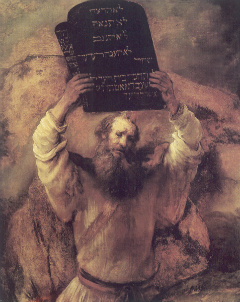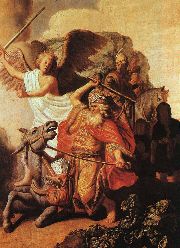REMBRANDT HARMENSZOON VAN RIJN
The Artist As Expounder of Truth

 Rembrandt Harmenszoon (son of Harmen) Van Rijn was born on July 15, 1606, in Leiden, Holland, in the Netherlands. He was born it the house No. 3 Weddesteg, on the rampart at Leyden overlooking the Rhine. The house belonged to his father Gerrit Harmen van Rijn, a well-to-do miller, and still exists today. He was the ninth of ten children. His family came from the Rhine River area. He came from a long line of millers and his father, Harmen Gerritszoon van Rijn (c. 1568-1630) was also miller who owned a half-share in a flour mill in Leiden. His mother, Cornelia van Zuytbrouk (1568-1640), was the daughter of a baker. A Protestant, she brought up her son with a thorough knowledge of the Scriptures, and for the remainder of his life, the Bible was one of the few books which occupied a place in his house.
Rembrandt Harmenszoon (son of Harmen) Van Rijn was born on July 15, 1606, in Leiden, Holland, in the Netherlands. He was born it the house No. 3 Weddesteg, on the rampart at Leyden overlooking the Rhine. The house belonged to his father Gerrit Harmen van Rijn, a well-to-do miller, and still exists today. He was the ninth of ten children. His family came from the Rhine River area. He came from a long line of millers and his father, Harmen Gerritszoon van Rijn (c. 1568-1630) was also miller who owned a half-share in a flour mill in Leiden. His mother, Cornelia van Zuytbrouk (1568-1640), was the daughter of a baker. A Protestant, she brought up her son with a thorough knowledge of the Scriptures, and for the remainder of his life, the Bible was one of the few books which occupied a place in his house.
Although he came from a family of modest means, Rembrandt's parents endeavored to provide him with an excellent education. He began his training at age 7 at the Latin School where grammar, classical literature, and religious studies were emphasized. By age 14 he was enrolled at the Leiden University. The program did not interest him however, so he left in 1621 at age of 15, to enter a 3 year apprenticeship to Jacot Isaacsz van Swanenburgh, an Italianate painter landscape art.
During the early years of his life at Leyden, Rembrandt devoted himself to studies, painting and etching the people about him, from every walk of life. In 1625, he started his own studio in Leiden along with Jan Lievens. Rembrandt found his first benefactor in Constantijn Huygens, a secretary of the city's governor, Prince Frederik.
His mother was a frequent model, and one may trace in her features the strong likeness to her son, especially in the portraits, of himself at an advanced age. So far as we know there is no likeness of his father, who died about 1632. The last portrait of his mother is that of the Belvidere Gallery of Vienna, painted the year before her death in 1640.
His most valuable training was received during the six months of 1624 that he spent in the studio of a painter of history, yet another Italianate painter, Pieter Lastman in Amsterdam. It was Lastman who introduced Rembrandt to the painting of historical and biblical subjects, with a dramatic, theatrical flair in high contrast and of large format. The painting Ahasveros and Haman at the Feast of Esther is one of the few works of Rembrandt van Rijn whose complete provenance is known. The origin of the painting can be traced back to 1662, two years after its completion. Rembrandt sold the painting Ahasuerus and Haman at the feast of Esther to Jan J. Hinlopen.
In his desire for historical accuracy, he collected numerous works of art, costumes, and props and curiosities, was continually improving and learning from the art and frequently using the various costumes in his portraits. In 1631 Van Rijn moved to Amsterdam and lived with the art dealer Hendrick van Uylenburgh. Rembrandt's work had become well known and his studio in Leiden was flourishing, when he moved to Amsterdam. He became the leading portrait painter in Holland and received many commissions for portraits as well as for paintings of religious subjects. Rembrandt never left the Netherlands, his homeland. At the height of his career he had 25 young people working for him and being taught by him, which, at the relatively high fee of 100 guilders a year - not all parents could afford so much for a son's apprenticeship - brought him 2,500 guilders annually.
REMBRANDT'S PAINTING SUBJECTS & METHODS

 Biblical subjects account for about one-third of Rembrandt's entire production. This was somewhat unusual in Protestant Holland of the 17th century, for church patronage was nonexistent and religious art was not regarded as important. In Rembrandt's early biblical works, drama was emphasized, in keeping with baroque taste.
Biblical subjects account for about one-third of Rembrandt's entire production. This was somewhat unusual in Protestant Holland of the 17th century, for church patronage was nonexistent and religious art was not regarded as important. In Rembrandt's early biblical works, drama was emphasized, in keeping with baroque taste.
His paintings are characterized by broad thick brush strokes and the use of layers of glazes to provide scenes with depth. Despite the existence of some alla prima sketches on panels, Rembrandt's preferred painting surface was a gray-toned canvas. The canvas is better suited for paintings carried out over several sittings, and the majority of Rembrandt's works were executed in this manner. Rembrandt first blocked in the composition in broad brush strokes, then built up paint layers, working from dark to light. The heavy use of impasto (areas of thickly-applied paint) lends the image a feeling of spontaneity and immediacy. In some areas the rough textures look as if they have been applied with a palette knife rather than a brush, while some of the fine lines of the hair have been etched into the paint by the artist’s brush-handle.
Rembrandt's paintings are characterized by luxuriant brushwork, rich color, and a mastery of chiaroscuro, an Italian term for a style using strong lights and heavy shadows to create depth in a painting and a center of interest. The use of a brown ground so that his paintings would emerge from the dark to light. His use of impasto in the light areas grew heavier and heavier, while his shadows became increasingly transparent. Rembrandt used it to emphasize the faces and hands in his portraits; what his subjects were wearing and their setting are of less importance, melding into a dark background.
The primer for the panels is white, probably glue-chalk gesso, covered with a transparent brown imprimatur of Burnt Umber mixed with varnish, which creates the golden glow characteristic of his work. His canvases are primed with a warm grey made from lootwit (lead white with chalk, ground in linseed oil) and Raw Umber, or sometimes with white lead alone, with a transparent brown imprimatur. His palette consisted of 1) Flake white 2) Yellow ochre 3) Red ochre 4) Charcoal black 5) sienna’s and 6) umbers.
MARRIAGE TO SASKIA VAN UYLENBORCH
In 1631, when Rembrandt's work had become well known and his studio in Leiden was flourishing, he moved to Amsterdam. He became the leading portrait painter in Holland and received many commissions for portraits as well as for paintings of religious subjects. He lived the life of a wealthy, respected citizen and met the beautiful Saskia van Uylenburgh, By 1631, Rembrandt had become financially involved with the Amsterdam art dealer Hendrik van Uylenburgh (c. 1587-1661). In 1633, Rembrandt became engaged to Van Uylenburgh's niece, the beautiful fair-haired Saskia (1612-1642) Born in Leeuwarden, Saskia was the youngest of eight children of Rombertus van Uylenburgh, a top lawyera wealthy and a town burgomaster and one of the founders of the University of Franeker. Saskia met Rembrandt by way of her cousin, Hendrick van Uylenburgh, a painter and an art dealer, whose parents had emigrated to Kraków in Poland. They married the following year. On June 22, 1634, Van Rijn married Saskia van Uylenburgh, the cousin of Hendrick Uylenburgh and the daughter of the burgermaster of Leeuwarden. The wedding took place in Het Bildt, where Saskia had been raised by her sister Hiskje and the husband Gerard van Loo, a lawyer and local city secretary. Saskia brought a substantial dowry as well as patrician status. Saskia herself was to be the subject of the largest number of single portraits during the 1630s. When he had no other model, he painted or sketched his own image. It is estimated that he painted between 50 and 60 self-portraits.
In 1639, Rembrandt and Saskia moved into their own house, renting in fashionable Nieuwe Doelenstraat, (Now the Rembrandt House Museum) in the Jodenbreestraat in the Jewish quarter; the mortgage to finance the 13,000 guilder purchase would be a primary cause for later financial difficulties. Rembrandt produced many of his works in a fashionable town house in Amsterdam which was purchased by the artist in 1639, when he was 33. It proved to be the scene of personal tragedy, when his wife and three of his children died here. The house also became a tremendous financial burden, and in 1660 Rembrandt was forced to move. The first three chilcren born to the Van Rijns died, before the surviving infant whom they named Titus was born. The death of their first child occured at only two months of age. Rumbartus, a son, had been named after Saskia's father. In February of 1636, the couple's first born child, Rombartus, who was only a few weeks old, died. A second and then third child, both girls, also died in infancy. It can be seen that Rembrandt’s work gradually became more sober during these years. In September 1641, they rejoiced at the birth (and survival) of their son, Titus. The complications of Saskia's 4 pregnancies weakened her health. In 1642, Saskia made a will leaving Rembrandt and Titus her fortune, Rembrandt acting as sole trustee for her son Titus, but with full use of the money till he should marry again or till the marriage of Titus. Although most of Rembrandt's share would be lost if he married. She died shortly after, still aged only 30, probably from plague or TB leaving the nine-month old Titus in his father’s care. She was buried in the Oude Kerk.
Geertje Dirckx (1600/1610-1656?) entered the household as a housekeeper and nurse for Titus in 1649, and Rembrandt entered into a relationship with her as his "common law wife." She was the model for several of his paintings. In 1654 they had a daughter, Cornelia, bringing them an official reproach from the church for "living in sin". At some time Rembrandt gave the jewels and rings which had belonged to Saskia, to the wet-nurse, Geertje Dircx, a gesture not much appreciated by the Uylenburgh family. A few years later Geertje expected Rembrandt to marry her, but such an arrangement would have resulted in the loss of Saskia's inheritance. When Geertje moved out and tried to sell the jewellery, Rembrandt went to court and had Geertje locked up in a madhouse, in Gouda. He never legally married her. She eventually sued him for "breach of promise and won."
Financial difficulty troubled Rembrandt, yet he seems to have had a happy home dispite the financial troubles. He tended to be extravagant, and when he purchased an expensive house in 1639, this put him deeply in debt. He acknowledged this weakness by painting himself as the Prodigal Son. Rembrandt featured himself in many of his biblical paintings. In The Raising of the Cross, he even kept himself in his modern clothes to emphasize his personal involvement in the crucifixion. He believed the personalities in the Bible were like those of his Amsterdam acquaintances. In 1640, Rembrandt's mother, Cornelia, died. Eventually his dark colours as well as his perceptive of painting and portraiture fell out of fashion with his prosperous Dutch patrons of the arts, who began to admire bright colours and the manner employed by painters such as the Flemish portraitist Anthony Van Dyke.

ECONOMIC HARDSHIPS IN HOLLAND
In the 1650s Amsterdam was hit by a massive economic depression. Rembrandt's mounting debts caused him to transfer the ownership of his house to Titus, in an attempt to save it from his creditors. This was not a successful move however. He was forced to declare bankruptcy. Saskia's relatives intervened legally, and formed a trust for young Titus. The large house was inventoried for a bankrupsy sale. Two rooms contained more than 50 pieces of artwork. Eventually the home was lost to the creditors as well as his expensive art collection. He sold his costume collection to pay debts. When the house was auctioned he, Titus and Hendrickje moved to a more modest abode on the Rozengracht. When he was thus prevented from selling his artwork he was forced to take a position with a firm set up by his servant Hendrickje and his son Titus. In 1663 Hendrickje died, and in February 1668 Titus married the daughter of an old family friend, Magdalena van Loo (1642-1669), but in 1668, he too died, the victim of another epidemic at 27 years of age.
Before Rembrandt himself died in 1669 he faced the additional grief of the death of his precious son, Titus of plague in 1668. The following year, Rembrandt died on the 4th of October 1669, at the age of 63, leaving behind one daughter, 650 paintings, 280 etchings, and 1,400 drawings. Among his last works is one of his most famous, The Return of the Prodigal Son.
Rembrandt lived and worked from 1639 till 1658 in the 17th century house which he purchased in difficult times, in the Breestraat section of Amsterdam. At the time of purchase, he did not have the full amount of the purchase price but believed that he could make the required payments, as he had been working solidly. Van Rijn's son Titus was born there and Saskia, his wife died while he was living there. He then moved to an artist's quarter in the Jordaan district of Amsterdam, eventually renting a relatively small house on the Rozengracht where he lived for the rest of his life. In his old age Rembradt continued to paint his own portrait as assiduously as in his youthful and happy days. About twenty of these portraits are known, a typical one being found in the National Gallery. When Rembrandt died on October 4, 1669, he was buried in an unknown rented grave in the Westerkerk, Amsterdam. The house which still exists in the Jodenbreestraat in Amsterdam, was made into a museum in 1911. There are only fifty-five authenticated Rembrandt drawings in the large museum collections and at the Rembrandthuis (the Amsterdam house where Rembrandt lived, now a museum) or in private collections.


Alana Campbell is an artist-illustrator, and published writer since 1986. She and husband Tom reside in Washington state.
Tom & Alana Campbell 5214 South 2nd Avenue Everett, Washington 98203-4113 Telephone (425) 252-2981